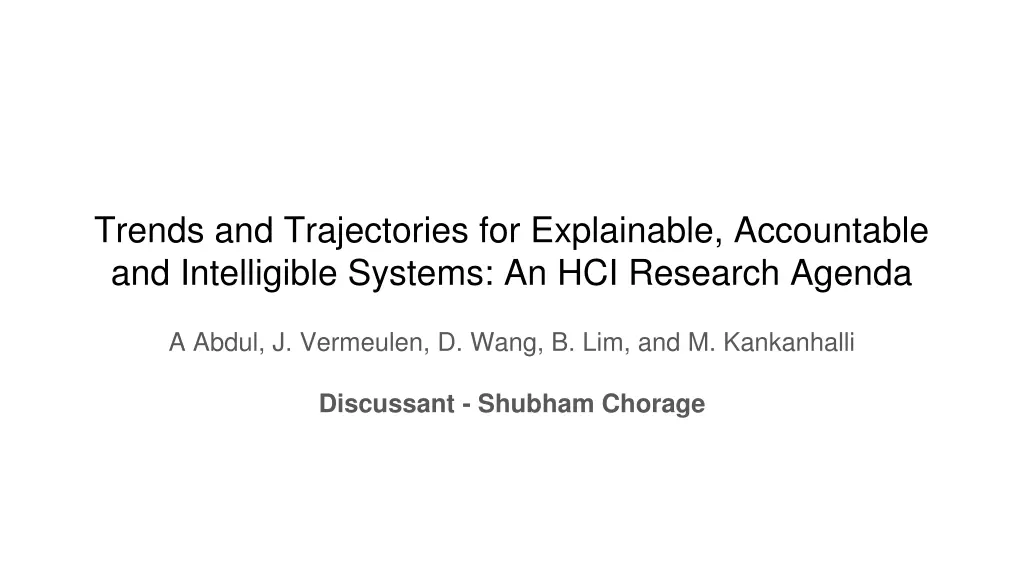
Exploring Trends in Explainable AI Research
Discover the growing importance of explainable AI and algorithmic transparency in today's society, with insights from HCI research on developing usable and effective systems for end-users. Explore Herbert Simon's perspective on the need for AI systems to be understandable and designed within cognitive limits. Gain valuable implications and directions for future HCI research on explainable systems.
Download Presentation

Please find below an Image/Link to download the presentation.
The content on the website is provided AS IS for your information and personal use only. It may not be sold, licensed, or shared on other websites without obtaining consent from the author. If you encounter any issues during the download, it is possible that the publisher has removed the file from their server.
You are allowed to download the files provided on this website for personal or commercial use, subject to the condition that they are used lawfully. All files are the property of their respective owners.
The content on the website is provided AS IS for your information and personal use only. It may not be sold, licensed, or shared on other websites without obtaining consent from the author.
E N D
Presentation Transcript
Trends and Trajectories for Explainable, Accountable and Intelligible Systems: An HCI Research Agenda A Abdul, J. Vermeulen, D. Wang, B. Lim, and M. Kankanhalli Discussant - Shubham Chorage
Relevance to Today's Research Growing Importance of Explainable AI and Algorithmic Transparency As AI and machine learning systems become more prevalent and influential in society, there is an increasing need for these systems to be explainable and transparent. This paper provides a comprehensive overview of research on explainable systems across multiple domains, which is highly relevant as explainable AI is a major focus area today. Interdisciplinary Landscape The paper maps out the research landscape across diverse fields like HCI, machine learning and cognitive psychology and provides crucial insights for explainable AI. HCI Perspective on Explainable Systems The paper argues for HCI researchers to take the lead in developing explainable systems that are usable and effective for end-users. This human-centered approach to explainable AI is increasingly recognized as critical today. Data-Driven Analysis at Scale The paper analyzes over 12,000 papers using computational techniques like topic modeling. This large-scale, data-driven approach to literature analysis is highly relevant for understanding broad research trends today. Agenda for Future Research The paper proposes several implications and directions for future HCI research on explainable systems. This helps shape the research agenda in this rapidly evolving field.
Herbert Simon's perspective on this research Bounded Rationality Simon agrees with the research on the need for AI systems to be understandable, also stressing that AI should be explicitly designed to accommodate the cognitive limits of users. AI systems must not just function well, but be designed for human comprehension. Implication for AI: Explainable AI (XAI) must present information that users can easily understand. Complexity and Simplicity While the paper supports simplification, Simon raises concerns about the risk of oversimplifying AI systems. He might question whether simplifying AI explanations compromises understanding of its inner workings. Relevance to AI: Explanations should simplify AI decisions without losing essential details. Design and Artificial Systems Simon agrees that AI must be transparent and user-centered. However, Simon would stress that AI must adapt to different user environments to remain functional and understandable. Application to AI: XAI should be transparent and tailored to human needs.
Herbert Simon's perspective on this research Synthesis and Explanation Simon agree that AI should make its internal processes visible to users. Simon would see XAI as an example of creating systems that clarify decision processes while functioning within user contexts. Insight for XAI: AI must make its internal logic visible to users. Conclusion The paper aligns with key principles of goal-oriented design and intelligibility, reflecting Simon s broader philosophy. Future developments can incorporate adaptive and functional designs, enhancing explainable AI s user-centric approach.
Lucy Suchmans perspective on this research Machine Agency: Human vs. Machine The paper suggests AI systems can be made fully intelligible, but Suchman would stress that machines cannot truly replicate the adaptive, situated nature of human behavior. Implication: AI systems should not aim to mimic human agency but should support human actions. AI systems have limited access to the context of human interaction, and contextual understanding is crucial. Limitations of Transparency Transparency in AI fails to capture the dynamic and situated nature of human actions. Suchman would critique the paper for focusing on transparency without adequately addressing the dynamic, evolving contexts in which AI operates. Context-Aware AI Design Suchman critiques the research stressing that AI systems design should recognize and adapt to the situated actions of users. AI must align with human needs in specific contexts, acknowledging that interactions are not static but evolve over time.
Lucy Suchmans perspective on this research Shifting to Complementarity The research aims towards making AI capable of imitating human behavior. Rather than trying to make machines more human-like, Suchman would suggest designing AI systems that complement human actions by supporting users within their specific contexts. Conclusion AI systems should not aim to fully replicate human intelligence but rather support and complement human actions. Suchman would encourage expanding the definition of explainability to include how systems respond to the real-time.
Learning from Explainable AI to Adaptive Task Manager for ADHD Users Bounded Rationality Systems must be designed to accommodate cognitive limits. Application: The Adaptive Task Manager will break down tasks into smaller steps, adjust reminders based on user focus patterns, and avoid overwhelming users. Complexity vs Simplicity Balance Balance between simplifying complex systems while retaining necessary functions. Application: Implementing features like Focus Mode and a Visual Dashboard to simplify task management while adapting to user needs. Adaptation to User Needs AI systems should be designed to fit user environments and goals. Application: Dynamic task adjustment in the Adaptive Task Manager will modify task difficulty and focus intervals based on user performance, ensuring a personalized experience.
Opportunities for Development based on Learnings from Explainable AI Enhanced Personalization Use machine learning to improve task breakdown and reminders based on real-time user data. Transparency & Feedback Provide clear, real-time feedback through the Visual Dashboard, showing users their progress and explaining adjustments in task management. Real-time Adaptivity Improve adaptivity by continuously learning from user data, further customizing task lists and focus modes dynamically. 8






















